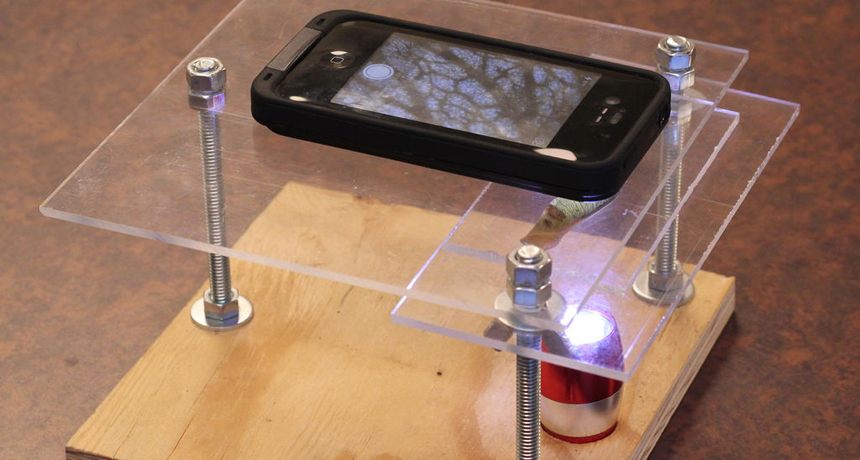Do-it-yourself microscope inventor aims to bring science to the people

Kenji Yoshino created the instructions to build this microscope using a smartphone and $10 worth of hardware.
Luke Saunders
Almost half a million people have looked at Kenji Yoshino’s instructions for making a microscope. Using only a smartphone, a laser pointer and some bits of plastic and wood, Yoshino can build a microscope that can magnify things up to 325 times, all for only $10. You can see individual salt crystals, plant cells and much, much more. While my own rendition of the do-it-yourself microscope didn’t go over so well, I had a great time talking to Yoshino about it.
Yoshino has a passion for bringing science to the people. He is currently a post-baccalaureate assistant for the Science Learning Center at Grinell College in Iowa. He has started local programs such as “Try this at home,” where kids 8-12 can learn how to do science with items from the grocery or hardware store. And he is no stranger to DIY projects. He once made a bow and arrow set out of a pair of skis!
This previous experience came in handy when he made his now famous DIY microscope. But he didn’t set out to build a microscope. He found instructions online on how to use the lens from the inside of a laser pointer, strapped to your smartphone camera lens, to make a magnifying glass.
He tried it himself, and it worked! But it had some problems. The lens sat tight against the phone, blocking out the light for things he was trying to look at. Soon he was arranging desk lamps trying to get a better view. He also had trouble holding his phone steady enough with just his hand. He propped it up on the desk, but then had trouble with focus.
So Yoshino made a list of the problems he had to solve: focus, light and keeping the phone steady. He then made a list of solutions that he had come up with. “And then,” he says, “I realized I was designing a microscope.”
And that’s what he built. As Yoshino went forward, the project took on a new spirit. He wanted to make it cheap. While he currently works with college students, he loves to work with younger students. College students, he says, “have made up their minds about whether they like science or not.” But with younger students, “you can give them that eureka moment, you can show them how science explains the world they live in. If you can get students to see the application of science in their own lives, they will become more involved in their education.” By making his microscope as cheap as possible, he hopes to get it into as many classrooms as he can, to help more students find their eureka moment.
So far, it looks like it’s working! His instructional video has gone viral, and is even getting picked up by groups in other countries. Many teachers have contacted him directly about the microscope, and many others chime in with comments on how to improve the design. A classmate of Yoshino’s has applied for a grant to produce the microscopes for the local science museum. Yoshino will be applying for more money to improve his design.
His microscope is far from finished. “I’d like to add an objective lens turret so you can rotate through different lenses to change the magnification without moving the camera or specimen,” he says. “I’d also like to make the light adjustable. Sometimes it’s too bright.” He would also like to partner with a cell phone recycling program, so people who may not have access to smartphones could get a phone to use for the project. With a little luck, the DIY microscope will be helping people around the world find their eureka moments.
Power Words
lens (in physics) A transparent material that can either focus or spread out parallel rays of light as they pass through it.
microscope An instrument used to see objects and details that are too small to see with the eyes alone.
post-baccalaureate fellow A position working at a university, often in a lab, for people who have just graduated college.